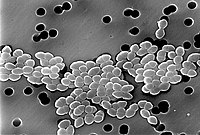
Photo from wikipedia
Objectives To characterize, phenotypically and genotypically, the first Enterococcus faecium clinical isolate harbouring a vanG operon. Methods The antibiotic resistance profile of E. faecium 16-346 was determined and its whole… Click to show full abstract
Objectives To characterize, phenotypically and genotypically, the first Enterococcus faecium clinical isolate harbouring a vanG operon. Methods The antibiotic resistance profile of E. faecium 16-346 was determined and its whole genome sequenced using PacBio technology. Attempts to transfer vancomycin resistance by filter mating were performed and the inducibility of expression of the vanG operon was studied by reverse-transcription quantitative PCR (RT-qPCR) in the presence or absence of subinhibitory concentrations of vancomycin. Results E. faecium 16-346 was resistant to rifampicin (MIC >4 mg/L), erythromycin (MIC >4 mg/L), tetracycline (MIC >16 mg/L) and vancomycin (MIC 8 mg/L), but susceptible to teicoplanin (MIC 0.5 mg/L). The strain harboured the vanG operon in its chromosome, integrated in a 45.5 kb putative mobile genetic element, similar to that of Enterococcus faecalis BM4518. We were unable to transfer vancomycin resistance from E. faecium 16-346 to E. faecium BM4107 and E. faecalis JH2-2. Lastly, transcription of the vanG gene was inducible by vancomycin. Conclusions This is, to the best of our knowledge, the first report of a VanG-type vancomycin-resistant strain of E. faecium. Despite the alarm pulled because of the therapeutic problems caused by VRE, our work shows that new resistant loci can still be found in E. faecium.
Journal Title: Journal of Antimicrobial Chemotherapy
Year Published: 2018
Link to full text (if available)
Share on Social Media: Sign Up to like & get
recommendations!